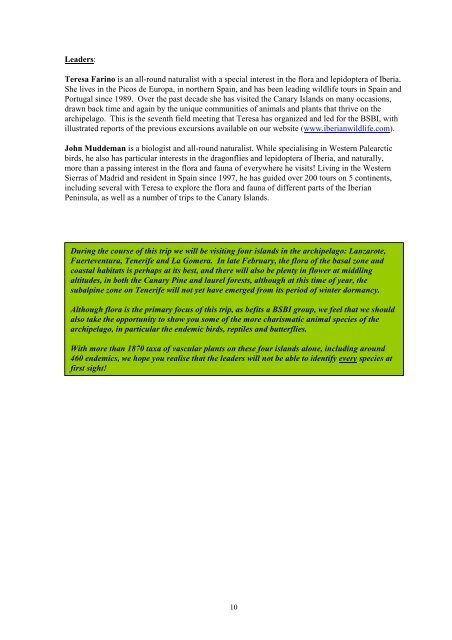Leaders:Teresa Farino is an all-round naturalist with a special interest in <strong>the</strong> flora and lepidoptera <strong>of</strong> Iberia.She lives in <strong>the</strong> Picos de Europa, in nor<strong>the</strong>rn Spain, and has been leading wildlife tours in Spain andPortugal since 1989. Over <strong>the</strong> past decade she has visited <strong>the</strong> Canary Islands on many occasions,drawn back time and again by <strong>the</strong> unique communities <strong>of</strong> animals and plants that thrive on <strong>the</strong>archipelago. This is <strong>the</strong> seventh field meeting that Teresa has organized and led for <strong>the</strong> BSBI, withillustrated reports <strong>of</strong> <strong>the</strong> previous excursions available on our website (www.iberianwildlife.com).John Muddeman is a biologist and all-round naturalist. While specialising in Western Palearcticbirds, he also has particular interests in <strong>the</strong> dragonflies and lepidoptera <strong>of</strong> Iberia, and naturally,more than a passing interest in <strong>the</strong> flora and fauna <strong>of</strong> everywhere he visits! Living in <strong>the</strong> WesternSierras <strong>of</strong> Madrid and resident in Spain since 1997, he has guided over 200 tours on 5 continents,including several with Teresa to explore <strong>the</strong> flora and fauna <strong>of</strong> different parts <strong>of</strong> <strong>the</strong> IberianPeninsula, as well as a number <strong>of</strong> trips to <strong>the</strong> Canary Islands.During <strong>the</strong> course <strong>of</strong> this trip we will be visiting four islands in <strong>the</strong> archipelago: Lanzarote,Fuerteventura, Tenerife and La Gomera. In late February, <strong>the</strong> flora <strong>of</strong> <strong>the</strong> basal zone andcoastal habitats is perhaps at its best, and <strong>the</strong>re will also be plenty in flower at middlingaltitudes, in both <strong>the</strong> Canary Pine and laurel forests, although at this time <strong>of</strong> year, <strong>the</strong>subalpine zone on Tenerife will not yet have emerged from its period <strong>of</strong> winter dormancy.Although flora is <strong>the</strong> primary focus <strong>of</strong> this trip, as befits a BSBI group, we feel that we shouldalso take <strong>the</strong> opportunity to show you some <strong>of</strong> <strong>the</strong> more charismatic animal species <strong>of</strong> <strong>the</strong>archipelago, in particular <strong>the</strong> endemic birds, reptiles and butterflies.With more than 1870 taxa <strong>of</strong> vascular plants on <strong>the</strong>se four islands alone, including around460 endemics, we hope you realise that <strong>the</strong> leaders will not be able to identify every species atfirst sight!10
INFORMATION FOR PARTICIPANTSDATESFriday 17 February to Friday 2 March 2012 (15 days, 14 nights)PRICEThe cost <strong>of</strong> this tour, including all international and inter-island flights, ferry crossings, half-boardaccommodation, picnic lunches, transport by minibus throughout (except during transfers from oneisland to ano<strong>the</strong>r), all entry fees and services <strong>of</strong> <strong>the</strong> leaders is £2350 per person, based on two peoplesharing a room. This price compares very favourably with that <strong>of</strong> trips to <strong>the</strong> Canaries organised by,for example, Naturetrek and The Travelling Naturalist in 2012.Single accommodation (see Accommodation, below) is only available at this point for our two nightson Fuerteventura, and costs £28 per person. However, depending on availability at <strong>the</strong> o<strong>the</strong>r variousapartment complexes in February, <strong>the</strong>re may be <strong>the</strong> option to upgrade to single-room occupancy onarrival (for which you might need to make an additional payment).ISLAND HOLIDAYSThis tour includes international and inter-island flights, and ferry crossings. To ensure yourfinancial protection, bookings will be taken by Island Holidays (ATOL number 2725). For moreinformation visit <strong>the</strong> Island Holidays website (www.islandholidays.co.uk). Booking forms andconditions have been attached as a separate pdf document, but can also be downloaded fromwww.islandholidays.co.uk/downloads/Island_Holidays_Booking_Form.pdf. When making abooking, please quote ‘BSBI Canaries’ where it says ‘Tour’.PARTICIPANTSThe maximum number <strong>of</strong> participants on this tour is 14, excluding <strong>the</strong> leaders.Although <strong>the</strong> tour is being <strong>of</strong>fered exclusively to members <strong>of</strong> <strong>the</strong> BSBI and <strong>the</strong>ir partners/friends in <strong>the</strong>first instance, in <strong>the</strong> event that <strong>the</strong>re are still places available three months prior to departure, wereserve <strong>the</strong> right to <strong>of</strong>fer <strong>the</strong>se to non-BSBI members via our website (www.iberianwildlife.com).For this tour <strong>the</strong>re is no minimum number <strong>of</strong> participants and Island Holidays confirms that <strong>the</strong>paragraph in <strong>the</strong>ir booking conditions relating to group size does not apply. The tour will go aheadeven with a small group <strong>of</strong> confirmed bookings, although we reserve <strong>the</strong> right to appoint just a singleleader (Teresa Farino) with up to eight clients.TRAVEL ARRANGEMENTSOn previous BSBI tours we have been able to accommodate flights from various UK regionalairports, but on this occasion (primarily because we fly into one airport and out from a differentone) this has simply not been possible. Thus, after much searching, we have found only one flightsuitable for this tour:• Friday 17 February 2012:easyJet Flight 8683: London Gatwick to Lanzarote (Arrecife), departs 07.40, arrives 12.05.• Friday 2 March 2012:easyJet Flight 8706: Tenerife South to London Gatwick, departs 19.05, arrives 23.20.NB The Canary Islands lie within <strong>the</strong> same time zone as <strong>the</strong> United Kingdom.You are advised to make your booking promptly to avoid disappointment, as obviously <strong>the</strong>re willbe a limited number <strong>of</strong> places available on <strong>the</strong>se flights.11
















